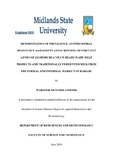Please use this identifier to cite or link to this item:
https://cris.library.msu.ac.zw//handle/11408/3711| Title: | Determination of prevalence, antimicrobial resistance assessment and screening of virulent genes of escherichia coli in ready-made meat products and traditionally fermented milk from the formal and informal markets in Harare | Authors: | Gweshe, Wardner Munashe | Keywords: | Escherichia coli Antimicrobial resistance |
Issue Date: | 2018 | Publisher: | Midlands State University | Abstract: | Escherichia coli is a common gastrointestinal enterobacteriaceae that contaminates food resulting in food poisoning. Due to prolonged exposure to antibiotic therapy in their livestock hosts, E. coli continue to develop antimicrobial resistance (AMR). Most E. coli strains are commensal but may attain virulence genes through horizontal gene transfer. A cross sectional observational study was carried out to determine the total E. coli count in polony, beef burgers and traditionally fermented cow milk from the formal and informal markets. The E. coli isolates were tested for antimicrobial resistance against eight commonly used antibiotics. A multiplex PCR was developed for the rapid detection of genes encoding Shiga toxins 1 and 2 (stx1 and stx2), intimin (eae A), and enterohemolysin A (hly A) under UV-Transillumination. From the 36 samples examined, 14 (39%) samples were E. coli positive. Escherichia coli was higher in the informal sector with 44% (8 of 18) prevalence than in the formal sector with 16% (3 of 18) prevalence. Polony had the highest total E. coli counts (TEC) (1.2 X 102 ≤ TEC ≤ 1 X 103) followed by burgers (9 X 101 ≤ TEC ≤ 3 X 102) and only a single sample of milk was E. coli positive with a TEC of 30. Intimin (eae A) was detected from 7% (1 of 14) isolates, two variants of stx gene (shorter with 406 bp and a longer one with 779 bp) were detected and hly was not detected. The shorter stx PCR band size was detected from 50% (6 of 14) isolates while stx 2 was detected in 7% (1 of 14) isolates. The absence of E. coli in fermented milk indicated the inability of E. coli to survive in fermented milk most probably due to the production of bacteriocin-like inhibitory substance with a broad spectrum of antimicrobial activity directed against pathogenic indicator organisms by the lactose fermenting bacteria found in milk. Antimicrobial resistance was 0% for Cephalexin, and relatively low for Trimethoprim/Sulfamethoxazole (21.4%), Ceftriaxone (28.6%) and Tetracycline (35.7%). A total of 6 (42.9%) isolates were extended-spectrum β-lactamase producers, which may have provided them with important resistance. About 49% (6 of 14) isolates were shiga-toxin producing and are potential causal agents of gastroenteritis, urinary tract infections and E. coli-associated neonatal meningitis. The shorter stx2 gene originates from Aeromonas spp. suggesting a high degree of Aeromonas spp. - E. coli horizontal gene transfer. The findings of this study indicate more violation of food handling standards in the informal sector which requires effective implementation and enforcement of food safety regulation in the food industry. The public is discouraged from buying ready-prepared meat products from the informal sector. The health delivery sector is also encouraged to diligently prescribe antibiotics with prudence as well as promote the use of herbal alternatives if rate of AMR is to be reduced. | URI: | http://hdl.handle.net/11408/3711 |
| Appears in Collections: | Bachelor Of Science In Applied Biosciences And Biotechnology Honours Degree |
Files in This Item:
| File | Description | Size | Format | |
|---|---|---|---|---|
| GWEHSE_DEISSERTATION_FOR_LIBRARY.pdf | Full Text | 1.1 MB | Adobe PDF |  View/Open |
Page view(s)
108
checked on Jan 14, 2025
Download(s)
72
checked on Jan 14, 2025
Google ScholarTM
Check
Items in MSUIR are protected by copyright, with all rights reserved, unless otherwise indicated.


